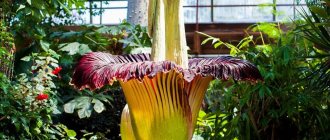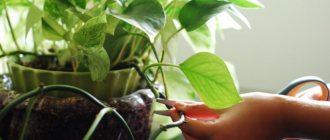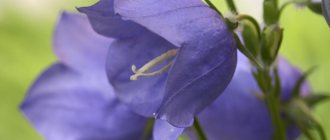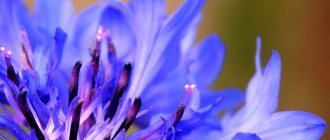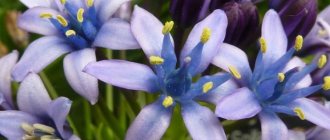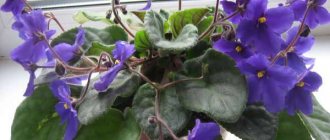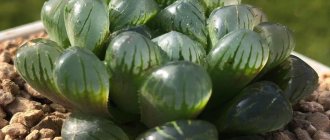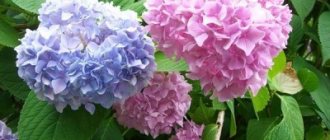Photos – 4
The color of this beautiful flower varies from blue to light green. Sometimes the Jade Vine is pollinated by bats, which can see the flower due to its ability to glow at night.
Natural pollinators and constantly changing environmental conditions make this plant very rare.
Yutan Poluo
For centuries, the existence of the Yutan poluo was considered nothing more than a myth, until a Chinese farmer named Mr. Ding found examples of these tiny white flowers, which are no more than 1 mm long. The flowers are mentioned in Buddhist scriptures, but they only bloom once every 3,000 years, so whoever sees them will be very lucky. This flower is native to China and Taiwan, as well as Korea, where it grows on the Buddha statue in front of Chongye Temple in Seoul.
Photos – 12
The "parrot's beak" is afraid of temperature fluctuations, which can lead to its death.
Today, only a few representatives of this species exist. The disappearance of this flower began in 1884.
Plants that survive in the Canary Islands are protected by law.
Chocolate orchid
The chocolate orchid is endemic to Mexico, but is now unfortunately extinct in the wild. The plant is so named because the scent it releases when it blooms smells like chocolate. Only one example of this unique burgundy flower exists today, a clone grown by scientists using a technique called vegetative propagation.
We talk in detail about growing orchids here
Photos – 16
Another feature of the Ghost Orchid is that it does not have leaves.
Because the stem and flowers of this orchid appear in green, it is difficult to spot even if you have a chance to get to where it grows.
The ghost orchid blooms only three weeks a year, between April and August.
Yellow-purple women's shoes
Women's shoes (Venus's Slipper) come from Great Britain. Solid yellow lady's slippers are common, but the yellow and purple variety currently only grows in one location. This is a hidden place on a golf course somewhere in the north of England. Efforts to protect these last remaining specimens in the wild are so intense that the exact location of the flowers is a secret, and they have been under government protection for decades.
Photos – 19
Kadupul or "Queen of the Night" . This beautiful flower is found mainly in the forests of Sri Lanka.
Few people are lucky enough to enjoy the beauty of kadupul, because it blooms only in the middle of the night and dies before dawn.
In addition, this plant requires special conditions for healthy flowering.
Kadapul flower
The Kadapul flower is found primarily in Sri Lanka and is considered the most expensive flower in the world for two reasons. Firstly, it opens only at midnight, and then closes again by dawn, and secondly, it dries up almost as soon as it is picked. This means that it cannot really be sold, which is why this flower is priceless. Not many people can see this rare flower or smell its wonderful scent. It is highly respected in Sri Lanka and has various nicknames including "Flower from Heaven" and "Queen of the Night".
Campion (Lichnis Gibraltar) Silene Tomentosa
The habitat of this rare species is rocks. The most suitable climate for it is in the area of the Strait of Gibraltar. For a long time, scientists believed that these rare flowers had disappeared forever, until they were rediscovered by a group of rock climbers in the 90s of the 20th century. Today the plant is grown under special conditions.
You can get acquainted with the rarest specimens in London's Royal Botanic Garden, or in its homeland, Gibraltar, where it is also cultivated. Its seeds are carefully protected in a special jar.
Parrot beak
Parrot's beak is another flower named for its visual similarity and is endemic to the Canary Islands. However, it is now believed to be either extinct or close to extinct in the wild because the sunbird - its only pollinator - has long since left the islands. The flower has been rare since the 19th century and blooms only in full sun, revealing fiery orange, red and yellow petals.
Himalayan giant lily Cardiocrinum
It is not surprising that the giant lily grows here. The Himalayas are a unique place with magical energy. For the main part of its life, the plant is a small, undistinguished tuft of leaves, but every 5 years it sprouts three-meter-long shoots and produces wonderfully fragrant flowers.
Cardiocrinum has been known to scientists for more than 200 years. Today it is grown in different climatic conditions.
Flower delivery is prompt and accurate.
Gibraltar Campion
Campion can only be found in Gibraltar. It was declared extinct in 1992, but then "rose from the dead" after being discovered in a nature reserve in 1994. Since then, extensive efforts have been made to preserve the remaining specimens and reintroduce them to the world so that its delicate aroma and vibrant colors, which range in shades from white to pink, can be enjoyed.
Corpse Flower
This flower gets its name because of the disgusting smell it emits when blooming. Unlike chocolate orchid, this is not the "scent" that people are usually looking for, as it is often compared to rotting flesh. They are parasitic plants that attach to hosts for water and nutrients, and the scent they emit attracts flies and other pollinators. They can grow up to 1 m in height and weigh up to 7 kg.
Franklinia
A tea plant discovered 200 years ago in the Alatamaha Valley in Georgia. The Bartham family of avid gardeners cultivated it even before it disappeared from the natural environment (due to deforestation), and was named after a family friend, Benjamin Franklin. Franklinia has magnificent white inflorescences, and large (up to 15 centimeters) green leaves turn orange-red in the fall. Moreover, a 6-10 meter tree continues to throw out flowers even after the leaves turn red. All plants to date come from those bred by this American family.
Predator Drosera Capensis (Cape Sundew)
Droplets of liquid serve both as glue, to which the insect firmly sticks, and as a digestive enzyme.
Cape sundew can also grow at home, but it requires an increased amount of moisture, some light and a certain temperature, not higher than 12°C. Create such conditions, and a real “exterminator” of mosquitoes, midges, and ants will appear on your windowsill.
Velvichia is amazing
A relict plant, one of the rarest in the world. Its habitat is limited to a narrow coastal strip (up to 100 kilometers) along the Atlantic Ocean in Namibia and Angola. The fact is that, growing in the Namib Desert, where there is practically no water, Velvichia receives moisture from morning fogs (ocean evaporation), and the further it grows, the more difficult it is for it to do this.
The seeds are viable for about 2 years and are very hygroscopic - at the slightest sign of moisture, they absorb every drop of it through thousands of mouths that close in the heat. The leaves are hard and feel like boards that cannot be scratched even with a nail. They can reach 8 meters in length, with a width of about a meter. Velvichia grows very slowly (up to 30 centimeters per year) and there are specimens with a lifespan of about 2 thousand years.
Dicentra is magnificent
The original shape of the flowers provided the plant with consonant names in many European languages: “Broken Heart” (in Russian), “Jeannette’s Heart” (from French), “Bleeding Heart” (in the English). Dicentra is a perennial plant with openwork leaves similar to a fern.
Flowers - small, bright hearts - hang on long stalks from arched shoots, reminiscent of holiday garlands. The unique buds of different types of dicentra can be painted in any shade of pink or remain snow-white. Delicate veil stamens peek out from the “split” tips of the hearts. New buds appear along the shoot as the previous ones fade.
This continuous “wave” of flowering continues for several months. Gardeners all over the world are attracted by the ability of dicentra to grow and set buds in shaded places. A decorative, touching plant is not as harmless as it seems. All parts of the dicentra contain strong poison. Introduced to Europe from Japan at the beginning of the 19th century, the plant created a real stir among gardeners.
People fought for the possession of an amazing rare flower at auctions, and aristocrats considered it an honor to have it in their garden. Dicentra has taken root well in temperate climates, becoming the object of constant selection.
Today, there are hybrids of every imaginable flower shade, including purple and yellow. In the wild, the plant is still found in several countries of the Far East and in China.
Unique flowers for bouquets and compositions
The basis of any composition or bouquet is fresh flowers, created in various combinations.
A beautifully crafted bouquet evokes a feeling of elegance, lightness and sophistication. Gerbera with delicate petals will add originality and a touch of tenderness to any composition. Juicy shades from cherry to yellow will give the bouquet the beauty of a sunset, which delights with amazing palettes. A bouquet with gerberas will amaze with the play of its colors. It will give a feeling of harmony and happiness, warmth of feelings and emotions, and will reflect all the tender words that the heart is afraid to utter.
Delicate gerbera is often used in bouquets
Alstroemeria is a flower of extraordinary beauty. Their delicate petals give a feeling of heavenly weightlessness, grace, sophistication and lightness. Flowers collected in a bouquet or composition will give a feeling of purity and innocent love, bring a warm spring, filling the world with colorful colors and expressive shades.
Alstroemeria in a bouquet is a ray of love and light, a sea of tenderness and a symphony of feelings. Insanely delicate bouquets and compositions of these flowers will enchant girls and women, giving a bright fountain of emotions and feelings.
Alstroemeria in a bouquet symbolizes only good things
A bouquet of flowers in the hands of a skilled florist can be turned into a real work worthy of admiration. But there are flowers in the world, compositions of which are worthy only of queens. But it is not even in their power to obtain such beauty.
Puya Raymonda
A plant of the bromeliad family, found at altitudes of 4 thousand meters in the Bolivian and Peruvian Andes. Interestingly, having appeared long before humans and outliving the dinosaurs, Puya Raymonda is now on the verge of extinction. Its habitat is incredibly small, and to the threats to life there are added frequent fires and cutting down of plants (for wall insulation and fuel).
This is one of the largest inflorescences in the world - on a 13-meter column with a diameter of 2.5 meters there are from 7 to 11 thousand cruciferous flowers, from which up to 12 million seeds are formed. But on rocky and windy soils, only a few offspring will be produced, since the lifespan of the seed is very short. The flower is able to protect itself - there are sharp thorns among the white inflorescences. When the flowers die, they turn purple. Puya seeds appear only after 80-150 years of life and, unfortunately, after flowering the plant dies.
We have to admit that it is obvious that people will never see most of the rarest flowers in the world in person. Now the rate of extinction of flora and fauna is 100 times higher than ever before in the history of planet Earth. All the more remarkable is the fact that flowers can be seen on our website and you can enjoy their incredible view.
Beautifully flowering exotics
The exotic plants listed above do not display particularly graceful blooms. They stand out for their foliage and stems, even roots. However, there are also crops that will delight you with pleasant flowers. A good example of such plants are domestic citrus fruits (pure species and hybrids equally).
Recently, the popularity of indoor pomegranate has been growing. It was possible to develop a number of miniature varieties capable of producing fruit. Moreover, these fruits are quite edible. And judging by the reviews, they are no worse than those sold in stores.
Homemade banana can also be considered a good alternative. This indoor plant also bears fruit. But we must take into account that some types of homemade bananas are fruit-bearing, while others are decorative, so you will have to make a clear choice.
You can also grow pineapple in your apartment.
You can also use:
- dates;
- olives;
- mango;
- rambutans;
- avocado;
- medlar;
- sprekelia.
A member of the bulbous family, Sprekelia blooms during the spring months. Its foliage will surprise no one, and its bright scarlet flowers are unforgettable. Externally, the plant looks like an orchid. The similarity is created by 6 elongated petals. 3 of them are on top, and 3 more are on the bottom.
Lachenalia, which also produces unusual flowers, can be an attractive choice. They rather resemble oblong tubes of different tones. These flowers are collected in thick brushes. They are characterized by yellow, red or orange color. “Flame” surrounded by bright green leaves - what could be more beautiful.
Unfortunately, tuberose is very rare. But this plant has a very sweet aroma. It is even used in the perfume industry. And the beauty of tuberose is extraordinary. It is also worth mentioning streptocarpus.
Gloriosa
A climbing plant from the Liliaceae family is distinguished by the amazing shape of its large (up to 12 cm) flower. In Gloriosa, all the bright petals of the bud are “inverted” and point their tips upward, and the stamens stick out like the legs of a fancy insect. Up to 5 flowers are formed on one shoot. Thin petals with wavy edges resemble tongues of fire, from which the entire bush makes an indelible impression.
Gloriosa flowers can range from yellow to fiery red. There are varieties with almost white, variegated or purple petals. Most often, the buds are colored differently inside and outside or have several shades. Tropical Africa and Asia are called the homeland of perennial vines. In Zimbabwe, the amazing Gloriosa flower is recognized as a national symbol.
The plant was successfully acclimatized in Oceania and Australia, where plantings had to be struggled due to the displacement of local species and the death of many animals. All parts of Gloriosa contain colchicine, which is poisonous to humans and animals. The same substance leads to the disappearance of the vine in India, where the dangerous plant is used for unconventional treatment.

